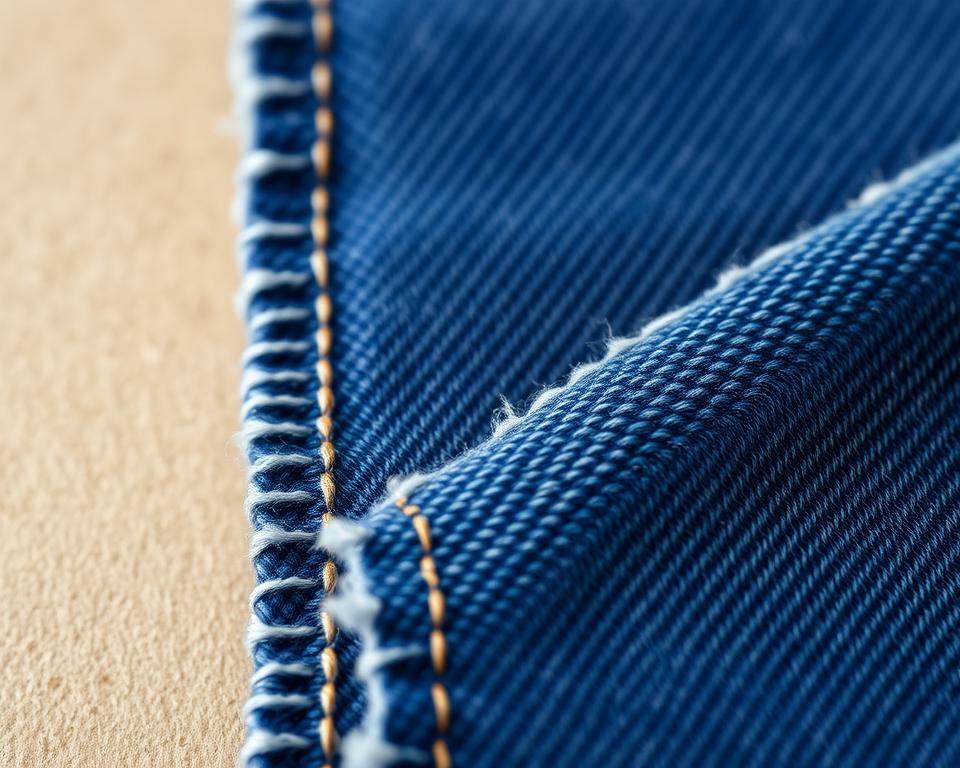Mastering Selvedge Denim Material: A Full Guide
A single pair of vintage Levi’s 501s from the 1940s recently sold for $87,400 at auction. Why were these trousers valued higher than a high-end automobile? It’s all due to their selvedge denim build.
This premium denim represents more than just fabric. It transports us back to when James Dean sported his 501s in Rebel Without a Cause, and Marlon Brando set the standard for cool in The Wild One. Those style icons didn’t merely don jeans. They wore Gold selvedge denim fabric manufacturers crafted on vintage shuttle looms.
Handcrafted denim earns its moniker from the self-finished borders that stop fraying. The word “selvedge” fuses “self” and “edge” to depict this singular weaving approach. Differing from factory-made denim, each yard of selvedge denim material requires patience and expertise to craft.
The texture tells a story through subtle irregularities and natural variations. Every pair acquires character as its indigo wears down. This individual progression renders heritage denim exceptional to collectors and style aficionados alike.
A lot of folks reckon premium denim outlasts standard jeans. The truth is more nuanced. Selvedge construction creates beautiful fabric with clean edges and rich texture. However, sturdiness relies on cotton caliber and heft, not merely on weaving style. What distinguishes craft denim is its capacity to age elegantly and form distinct faded patterns as time passes.
Defining Selvedge Denim Material
Selvedge denim textile differs from common denim on account of its exclusive construction and self-finished edges. It’s titled after its “self-edge,” a closely woven strip that blocks fraying. This premium material embodies a dedication to slow fashion and traditional craftsmanship, setting it apart from mass-produced denim.

Decoding Self-Edge Construction
The word “selvedge” fuses “self” with “edge,” indicating material with a tidy, sealed edge. This narrow selvage appears on both sides of the fabric, doing away with extra finishing. Old-school mills craft it at roughly 30–32 inches wide, unlike contemporary denim’s 60-inch span.
Why Shuttle Looms Yield Distinct Fabric Edges
Shuttle-loomed denim’s essence stems from classic weaving machines operating more slowly. They shuttle one weft yarn across the warp threads in one continuous action. This process yields:
- Organic textural slubs
- A gentler hand-feel compared to contemporary denim
- Tightly bound edges that won’t fray
- Genuine irregularities prized by denim fans
Selvedge vs. Standard Denim
Standard denim is made on projectile looms that shoot weft yarns across wider fabric. Such weaving leaves loose edge fibers requiring overlock stitching to stop fraying. Selvedge denim fabric, however, requires extra time in production. It delivers enhanced durability and a distinct look, warranting its premium price.
Origins and Evolution of Shuttle-Loomed Denim
Heritage denim’s story began in 19th-century American textile mills. Shuttle looms played a vital role, crafting cloth with self-finished edges to stop fraying. This method produced indigo-dyed denim at a slow, meticulous pace, ensuring each yard was crafted with care. The narrow width of this fabric became a hallmark of artisanal denim production.
From 1800s American Mills to Modern Revival
For over a century, American mills relied on shuttle looms. Names such as Cone Mills and White Oak furnished top denim to workwear makers. By the 1970s, faster projectile looms took over, replacing most shuttle equipment. This shift was driven by the need for cheaper, mass-produced jeans. Many historic mills closed or modernized, leaving vintage looms to gather dust.
How Japan Revived Selvedge Denim
In the 1980s, Japanese producers brought American shuttle looms back into use. The Osaka Five labels headed this resurgence:
- Studio D’Artisan
- Evisu
- Fullcount
- Warehouse
- Denime
They combined American heritage style and Japanese meticulousness. They researched antique Levi’s templates, reproducing classic indigo denim textures. By the year 2000, Japan ruled the world’s artisan denim scene.
Why Old-School Weaving Techniques Matter Today
Shuttle looms produce unique fabric characteristics that modern machines can’t match. This slower method fosters subtle irregularities and fuller indigo soak. Premium denim enthusiasts cherish these imperfections as signs of authentic craftsmanship.
| Shuttle Loom Features | Modern Loom Features |
|---|---|
| 29-31 inch fabric width | 60+ inch fabric width |
| 3-4 yards per hour | 15-20 yards per hour |
| Natural irregularities | Uniform texture |
| Self-finished edges | Cut edges requiring overlocking |
Making Premium Denim on Antique Looms
The creation of premium denim starts with the rhythmic motion of vintage shuttle looms. These machines differ from today’s technology. They shuttle yarn across the full width at once, binding edges without further work. This method ensures selvedge denim has a clean, non-fraying edge.
Old shuttle looms turn out a mere 5 to 6 meters of striped denim fabric each day. This is in stark contrast to modern machines, which can weave 200 meters. The unhurried pace advantages the yarn via:
- Less tension on fibers creates a softer hand feel
- Natural irregularities remain intact for unique texture
- Irregular topography crafts unique fade patterns
- Slim widths (around 29–32 inches) cut down waste
Manning these age-old looms calls for seasoned artisans. Operators fine-tune tension, track cadence, and carry out maintenance. Each loom has its own unique character. Some date back to the 1920s, needing specific knowledge passed down through generations. This tactile method turns shuttle-loomed denim into an authentic artisan good.
The narrow width of dry denim from vintage looms has a practical benefit. Denim craftsmen can employ the finished edge as the outseam, cutting waste. This showcases the fabric’s authentic construction. Every roll has its own story, with subtle variations that mass production can’t replicate.
Raw Denim vs. Selvedge: Key Distinctions
A lot of denim fans mix up raw denim and selvedge denim. This confusion arises when shopping for premium jeans. The truth is, these terms describe different aspects of denim production. Recognizing the distinction empowers you to choose wisely and admire each type’s special qualities.
Why Selvedge Isn’t Always Raw
Selvedge indicates the shuttle-loom weave that forms self-finished borders. Raw denim means unwashed fabric straight from the mill. A selvadge raw denim fabric wholesaler might offer both washed and unwashed options. Brands like Naked & Famous produce selvedge jeans, sometimes pre-washed or with stretch.
The weaving technique remains the same. Yet, the finishing process changes everything about the fabric’s feel and look.
Washed and Unwashed Denim Compared
All denim starts as dry denim prior to wash. Mills produce both standard and selvedge versions unwashed. The main differences are:
- Raw denim evolves custom fade patterns via use
- Washed denim delivers immediate softness and size consistency
- Sanforized raw shrinks minimally post-first wash
- Unsanforized denim shrinks notably upon soaking
Breaking Down Common Misconceptions
Not all raw denim comes from shuttle looms. Contemporary projectile looms likewise churn out unwashed textile. The appeal often overlaps because buyers value durability, personalization, and craftsmanship in both selvedge and raw denim. Both types attract denim heads willing to invest time for that perfect custom fade.
Spotting Genuine Selvedge Denim Traits
When you’re in the market for selvadge raw denim fabric wholesaler, being able to spot genuine selvedge denim material is key. It sets you apart from ordinary buyers. Real selvedge denim has unique traits that set it apart from regular denim. Recognizing these markers certifies you’re purchasing genuine premium denim.
Finding the Selvedge ID
The simplest way to identify selvedge denim is by checking the outseam. Turn up the cuff and look at the seam along the outside of the leg. True selvedge denim exhibits a crisp, bound edge featuring colored threads. Its self-finished perimeter does away with overlock seams used in ordinary denim.
When you cuff your jeans, the selvedge ID becomes visible, adding a unique touch to your style. The colored edge yarns run continuously down the outseam, creating that signature look denim enthusiasts adore. By contrast, non-selvedge jeans sport cut edges bound by serger stitches to stop fraying.
Identifying High-Quality Construction
High-grade premium denim shows distinct assembly details:
- Dense, uniform weaving free of stray threads
- Clean selvedge edges without additional stitching
- Stable colored yarn running the full outseam
- Dense fabric weight typical of shuttle-loom production
Why Rainbow and Redline Selvedge Are Unique
Rainbow selvedge denim features multiple colored yarns in the selvedge ID, creating a unique multicolor edge. Redline selvedge, the most famous variety, uses red yarns for the ID and traces back to vintage American mills. These special selvedge styles command higher prices due to their rarity and visual appeal. Many labels emphasize these traits in their descriptions, simplifying the hunt for real heritage denim.
Why Craft Denim Costs More
Newcomers are often astonished by artisanal denim price tags. A pair of selvedge jeans can be three to five times pricier than mass-produced ones.
Comprehending what drives these costs shows the actual value of premium denim.
Shuttle looms run far more slowly than contemporary looms. Though factory looms crank out fabric fast, old shuttle looms manage only 1–2 meters hourly. That unhurried pace means crafting a bolt of heritage denim spans days, not hours.
The slender breadth of selvedge fabric hikes up costs. Unlike standard denim, which comes in 60-inch widths, premium denim from shuttle looms is just 28-32 inches wide. This restricted width entails meticulous layout and cutting to minimize waste.
Craft denim making happens in small runs. Mills like Okayama’s White Oak and Kuroki prioritize quality over quantity. They staff master artisans who manage each stage:
- Hand-checking yarn tension
- Adjusting loom settings for each fabric type
- Inspecting every meter for flaws
- Managing rope-dyeing processes that take weeks
These denim makers view their craft as art. They play with distinct yarns and hone indigo-dye recipes handed down through the lineage. By investing in heritage denim, you support mills preserving textile traditions and workers committed to their craft.
Where to Buy Black Selvedge Denim Fabric Wholesale
The high-end denim scene has expanded past Japan’s classic mills. American brands now compete, providing a wide range of black selvedge denim fabric wholesale. Finding top suppliers means knowing quality indicators and authentic fabric sources.
Identifying Quality Wholesalers and Mills
Premium suppliers highlight classic weaving and heartfelt commitment to artistry. Hunting for a selvedge raw denim wholesaler? Seek out mills still running shuttle looms. They list full specs: fabric heft, weave design, and dye techniques.
Leading Gold Selvedge Denim Mills
Gold-ID selvedge producers spotlight rich edge threads, boosting denim opulence. Top factories craft these niche fabrics in small batches, drawing boutique labels. The gold thread ID gives these fabrics a unique finish, distinguishing them from standard options.
How to Procure Nep Denim and Unique Weaves
Specialty fabrics like nep denim need specific sourcing channels. Nep denim shows deliberate specks for standout aesthetics. Dealing straight with manufacturers secures supply of these specialty textiles.
| Fabric Type | Minimum Order | Lead Time | Price Range per Yard |
|---|---|---|---|
| Black Selvedge | 500 yards | 6-8 weeks | $12-18 |
| Gold ID Selvedge | 300 yards | 8-10 weeks | $15-22 |
| Nep Denim | 400 yards | 10-12 weeks | $14-20 |
Popular Selvedge Styles and Fabric Variations
The world of selvedge denim fabric goes beyond basic indigo. Currently, manufacturers produce varied textures and designs. These demonstrate shuttle-loom weaving’s flexibility. Spanning delicate textural shifts to vivid motifs, they present distinct character that matures gracefully with wear.
Exploring Slub Denim Texture
Slub denim’s unique textured surface originates from thick-thin yarn variations. They feature thick and thin zones, yielding an organically varied fabric face. On shuttle looms, they create slub-textured selvedge denim with random fade patterns.
Every slub denim pair evolves a distinct fade motif. The raised slubs fade differently than the flat parts, ensuring no two pairs look alike.
Herringbone Selvedge Denim Fabric Characteristics
Herringbone selvedge denim fabric has a distinctive zigzag pattern, resembling fish bones. The pattern forms diagonal ribs that reverse direction periodically. The pattern adds visual interest and gives the fabric extra strength.
Brands like Iron Heart and The Strike Gold routinely utilize this weave in their top-tier offerings.
Striped Denim and Other Unique Weaves
Striped denim uses alternating threads to form vertical or horizontal stripes. Workrooms produce these stripes by alternating colored yarns in the weave. Notable variants include:
- Hickory stripe with alternating indigo and white
- Railroad stripe featuring thin pinstripes
- Wabash stripe with printed dots over stripes
| Fabric Type | Visual Pattern | Fade Characteristics |
|---|---|---|
| Slub Denim | Bumpy, irregular surface | High contrast, uneven fading |
| Herringbone | Zigzag diagonal lines | Subtle vertical streaking |
| Striped Denim | Alternating color bands | Pattern remains visible after fading |
Care Tips for Your Heritage Denim
Heritage denim needs particular attention to evolve its distinct personality. Raw and dry denim, unlike typical jeans, change shape with wear. They craft individual fade narratives reflecting your life.
The first few weeks with artisanal denim can feel stiff and uncomfortable. This is normal. It takes time for the cloth to soften and contour your form. Some wearers hasten the softening by donning them in the shower or squatting when damp. Others prefer a slower, more natural break-in period.
Raw denim shows top fade patterns when you postpone laundering. Skin oils and regular friction form whiskers by the knees and honeycombs at the rear. Numerous denim heads wait half a year before the initial wash, with some waiting a full year. This patience rewards you with high-contrast fades unique to your movement patterns.
When washing dry denim, flip it and rinse in cold water. Forego spin and drip-dry in shade. Some choose hand-washing in a tub with mild soap. Refrain from hot washes and dryers to prevent shrinkage and loss of fades.
Your heritage denim investment grows more valuable with proper care. Each wear adds character, making your jeans truly one-of-a-kind. The stiff beginning morphs into a snug second skin echoing your habits.
Where You Can Purchase Quality Indigo Denim Now
The revival of selvedge denim has unlocked new paths for denim lovers. Major retailers now carry indigo-dyed denim alongside specialty stores focused on premium denim and slow fashion. This helps buyers locate real selvedge choices across price ranges for any budget or taste.
Levi’s sells its 501 Original Fit Selvedge for $148, bringing heritage craft to more people. Uniqlo offers its Selvedge Straight at $50, striking a balance between style and price. For those looking for higher-end options, Buck Mason features Japanese Loom State Selvedge Full-Saddle Jeans at $248. Iron Heart elevates artisan denim with its 634s-18 Vintage Denim for $385, sold at Self Edge.
U.S. labels such as Todd Snyder and Buck Mason now rival Japanese experts in the selvedge arena. They understand that heritage weaving and top quality drive slow fashion. Whether shopping online or in physical stores, quality indigo-dyed denim is more accessible than ever to American consumers who cherish authentic craftsmanship.


